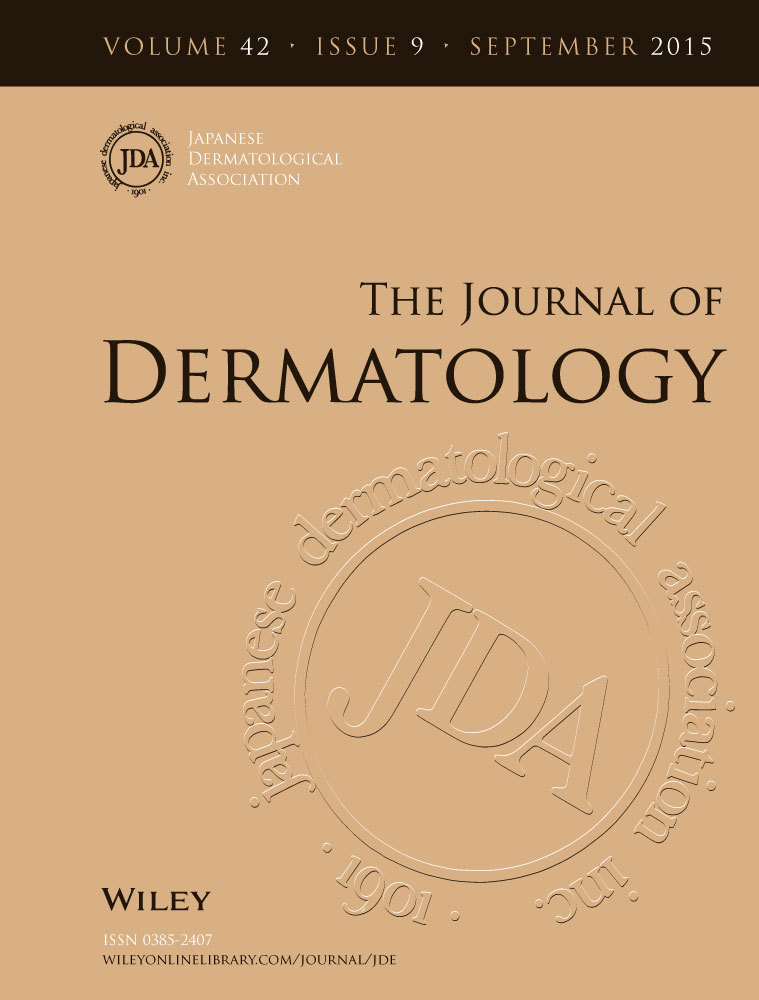Case of anaphylactic reaction to soy following percutaneous sensitization by soy-based ingredients in cosmetic products
Corresponding Author
Akiko Yagami
Department of Dermatology, Fujita Health University School of Medicine, Toyoake, Japan
Correspondence: Akiko Yagami, M.D., Ph.D., Department of Dermatology, Fujita Health University School of Medicine, 1-98 Dengakugakubo, Toyoake, Aichi 470-1192, Japan. Email: [email protected]Search for more papers by this authorKayoko Suzuki
Department of Dermatology, Fujita Health University School of Medicine, Toyoake, Japan
Department of Dermatology, Kariya Toyota General Hospital, Kariya, Japan
Search for more papers by this authorMasashi Nakamura
Department of Dermatology, Fujita Health University School of Medicine, Toyoake, Japan
General Research and Development Institute, Hoyu, Nagakute, Japan
Search for more papers by this authorAkiyo Sano
Department of Dermatology, Fujita Health University School of Medicine, Toyoake, Japan
Search for more papers by this authorYohei Iwata
Department of Dermatology, Fujita Health University School of Medicine, Toyoake, Japan
Search for more papers by this authorTsukane Kobayashi
Department of Dermatology, Fujita Health University School of Medicine, Toyoake, Japan
Search for more papers by this authorKazuhiro Hara
General Research and Development Institute, Hoyu, Nagakute, Japan
Search for more papers by this authorReiko Teshima
National Institute of Health Sciences, Tokyo, Japan
Search for more papers by this authorKayoko Matsunaga
Department of Dermatology, Fujita Health University School of Medicine, Toyoake, Japan
Search for more papers by this authorCorresponding Author
Akiko Yagami
Department of Dermatology, Fujita Health University School of Medicine, Toyoake, Japan
Correspondence: Akiko Yagami, M.D., Ph.D., Department of Dermatology, Fujita Health University School of Medicine, 1-98 Dengakugakubo, Toyoake, Aichi 470-1192, Japan. Email: [email protected]Search for more papers by this authorKayoko Suzuki
Department of Dermatology, Fujita Health University School of Medicine, Toyoake, Japan
Department of Dermatology, Kariya Toyota General Hospital, Kariya, Japan
Search for more papers by this authorMasashi Nakamura
Department of Dermatology, Fujita Health University School of Medicine, Toyoake, Japan
General Research and Development Institute, Hoyu, Nagakute, Japan
Search for more papers by this authorAkiyo Sano
Department of Dermatology, Fujita Health University School of Medicine, Toyoake, Japan
Search for more papers by this authorYohei Iwata
Department of Dermatology, Fujita Health University School of Medicine, Toyoake, Japan
Search for more papers by this authorTsukane Kobayashi
Department of Dermatology, Fujita Health University School of Medicine, Toyoake, Japan
Search for more papers by this authorKazuhiro Hara
General Research and Development Institute, Hoyu, Nagakute, Japan
Search for more papers by this authorReiko Teshima
National Institute of Health Sciences, Tokyo, Japan
Search for more papers by this authorKayoko Matsunaga
Department of Dermatology, Fujita Health University School of Medicine, Toyoake, Japan
Search for more papers by this author
References
- 1Holzhauser T, Wackermann O, Ballmer-Weber BK et al. Soybean (Glycine max) allergy in Europe: Gly m5 (b-conglycinin) and Gly m6 (glycinin) are potential diagnostic markers for severe allergic reactions to soy. J AIIergy Clin lmmunol 2009; 123: 452–458.
- 2Niinimäki A, Niinimäki M, Mäkinen-Kiljunen S, Hannuksela M. Contact urticaria from protein hydrolysates in hair conditioners. Allergy 1998; 53: 1078–1082.
- 3Strid J, Hourihans J, Kimber I et al. Epicutaneous exposure to peanut protein prevents oral tolerance and enhances allergic sensitization. Clin Exp Allergy 2005; 35: 757–766.
- 4Yagami A, Suzuki K, Nakamura M et al. Occupational food allergy due to parvalbumin and phaseolin induced by epicutaneous sensitization. Allergol Int 2015. doi: 10.1016/j.alit.2015.03.005.
10.1016/j.alit.2015.03.005 Google Scholar




